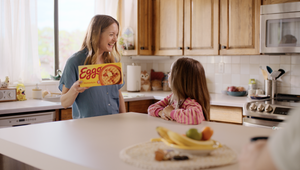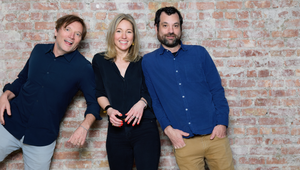
How FCB Showed Teens the Real Cost of Smoking

In the latest instalment of ‘The Real Cost’ (TRC) - a campaign that the US Food and Drug Administration (FDA) has run since 2014 - we see an auctioneer auctioning off a pack of cigarettes. Evolving from the campaign’s original insight that you pay for cigarettes not with money but with your health, the ‘Auctioneer’ spot shows teenagers bidding for the smokes with “a good night’s sleep”, “your ability to concentrate”, “peace of mind” and more.
Targeted at gen z, this new TRC entry also includes a film titled ‘Said Every Smoker Ever’ which shows how young people try to rationalise their smoking and believe that they will avoid becoming addicted like the adults around them. Both films and a variety of activations across social media (TikTok and Snapchat), digital and radio aim to provoke teens to rethink what they know about the dangers of smoking. As well as addressing the usual physical symptoms often associated with smoking - longer-term health issues and addiction - the campaign sets out to inform its young audience about the immediate effects cigarette cravings and withdrawal will have on their mental health and wellness too.
To discuss how the campaign is designed to inform gen z without inciting pushback from the notoriously defiant 11-19 age group, LBB’s Ben Conway spoke with FCB’s team behind the project: Dimas Adiwiyoto, SVP, group account director, Scott Karambis, SVP, group strategy director and Gary Resch, EVP, executive creative director. The creatives spoke about making teens readjust their assumptions about tobacco, how to communicate with a group that has become desensitised to previous messaging, and why mental health was an effective route to take.
LBB> How long has FCB NY been working with the FDA? What was the brief for this campaign like?
FCB NY> We’ve been partners for over a decade and we launched the ‘The Real Cost’ (TRC) brand nine years ago. Over the years, we’ve built incredible trust and partnership together that allows us to create powerful public health messages such as the ‘Auctioneer’ campaign. Our briefs have always looked deceptively simple, but in reality, they are extremely complex because they require us to align on most advanced scientific research on nicotine and addiction with the cultural context that is influencing teen behaviour. Regardless of the tobacco product (cigarettes, vapes, dip) that we need to warn teens about, our challenge is to make teens rethink their assumptions about the risks of tobacco.
LBB> How do you strike a balance to achieve the right tone for a campaign like this?
FCB NY> Our job is to provoke teens to rethink their behaviours and attitudes toward tobacco. So in all of our creative messages and with all of our media channel selections, we always strive to elicit a strong emotional reaction from teens because we don’t want them to ever ignore us.
LBB> How did you create this campaign for that teen audience? Did you do any research to support your approach?
FCB NY> 90% of adult smokers start before they are 18, so, from a public health perspective, the smoking problem is a teen smoking problem. For this reason, TRC has focused on teenagers since the origin of the campaign in 2014. But because young people are always ageing in and out of their teenage years, we are constantly speaking with them to understand their changing perceptions about smoking, as well as the impact of various messages. Decades of prevention messages have persuaded the vast majority of teens to avoid smoking, but over 1,000 teens were still trying cigarettes every day. Clearly, there was a group of teens that the existing warnings were not persuading. Through our research, we sought to identify new messages about immediate and relevant consequences that would persuade these remaining teens. National public health surveys indicated that the teens still experimenting were disproportionately concentrated in rural areas. For this reason, we also explored using contexts and settings, like auctions, that were particularly relevant to their lives.
LBB> Where did you get the statistics and the auctioneers’ ‘costs’ from? How did your research influence the campaign?
FCB NY> Anyone who has raised a teen (or has been a teen!) knows that teens have notoriously poor judgement about the long-term consequences of risky behaviour. They feel invincible and even though they are well aware that smoking is dangerous - even fatal - those who experiment with cigarettes believe they will quit long before they face any serious consequences. Cancer, heart disease, emphysema - these are old people’s problems. Plus, they’ve heard them all before, and have become desensitised to the risks. We’ve learned that new-to-the-world, immediate costs are much more effective at countering teens’ rationalisations for their risky behaviour. This was one reason we focused on mental health consequences. They probably hadn’t heard about this before. As a public education campaign for the FDA, ‘The Real Cost’ is held to a very high standard of scientific rigour. The sources for these ‘costs’ and statistics are ongoing academic research on tobacco, nicotine, and addiction. In fact, every word put in our ads is supported by multiple studies and reviewed by the FDA CTP’s Office of Science. The challenge for FCB is to transform these hard scientific facts into compelling, attention-getting communications that teens can’t ignore or dismiss.
LBB> The campaign is being run on Snapchat and TikTok - what was the strategy behind its digital release? And how did you create the spots with these social formats in mind?
FCB NY> Cigarette use among teens is at its historic lows; however, there are still specific teen populations who are extremely at risk for smoking due to various factors. To reach them, we’ve deployed a highly targeted, addressable, programmatic digital media plan that also includes Snapchat and TikTok. These are the channels where teens are consuming most of their media content, so when we briefed this campaign, we knew that we needed to make sure that all of our creative content was always social- and digital-first.
LBB> How did you develop the idea for the ‘Auctioneer’ spot? Was this a long-term idea from the start of ‘The Real Cost’ initiative? It focuses on mental health too - what can you tell us about that?
FCB NY> ‘The Real Cost’ launched nine years ago with a campaign that depicted teens using their healthy skin, teeth, and gums as currency to purchase cigarettes in a convenience store. So yes, this was sort of a full circle back to our initial launch. Different health consequences and different settings, but the same basic premise: You’re paying with more than money.
Gen Z is way more open to discussing mental health challenges than previous generations. The conversations were already happening, so this was a good time for us to join in. We wanted to craft the messaging like we do with a lot of our campaigns, with an understanding that we need to be provocative and entertaining in order to be heard.
LBB> The final warning about anxiety feels particularly strategic as it’s a hot topic, as well as a relatively under-the-radar side-effect of smoking. Why was this chosen as the final statement?
FCB NY> Like any brand striving to change behaviour, we look for ways to enhance the impact of our message through cultural relevance. And we were, of course, aware of the national attention to the growing teen mental health crisis, but we were also hearing the concern reflected in our primary research. In the past, teens often claimed they tried cigarettes ‘to fit in’ or rebel against mainstream conventions. But gen z teens were telling us they experimented with cigarettes to manage their stress and anxiety. At the same time, scientific research was focusing more on the relationship between nicotine addiction and mental health issues, from anxiety and depression to symptoms like insomnia. In focus group research with our target [demographic], we explored a number of different ways to link smoking to mental health, and anxiety was the most broadly relevant and impactful.
LBB> Were you on set at all? If so, what was that process like? Do you have any interesting anecdotes or lessons learned from that experience?
FCB NY> We were on set for this shoot. This particular shoot went very smoothly, and that’s a tribute to a great director (Yann Demange) and his team at Reset Content, as well as the teams at JSM Music and CARTEL Editorial. One of the lessons learned from this production is that when you have a good concept, trust it. No one felt the need to dress it up with too many bells and whistles. There’s a simplicity in the telling of these stories that disguises the fact that there was some serious craft being applied.
LBB> What was the hardest challenge you faced on this campaign and how did you overcome it?
FCB NY> We know that teens are not waiting for an anti-smoking campaign and, in fact, when they do see one, they’re likely to push back in their usual defiant nature. So our hardest challenge has always been to make sure that our creative message is effective with our audience before introducing it to the broader population. This body of work was tested extensively in qualitative and quantitative research, so we have high confidence that teens will be receptive to this message.















